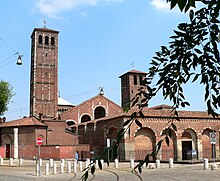Ambrosian Basilica
| Basilica of Sant'Ambrogio (Basilica di Sant'Ambrogio) |
|
|---|---|

Exterior view of the basilica.
|
|
| Basic information | |
| Location | Milan, Italy |
| Geographic coordinates | Coordinates: 45°27′44.73″N 9°10′32.90″E / 45.4624250°N 9.1758056°E |
| Affiliation | Roman Catholic |
| Province | Milan |
| Country | Italy |
| Year consecrated | 379 |
| Ecclesiastical or organizational status | National monument |
| Status | Active |
| Architectural description | |
| Architectural type | Church |
| Architectural style | Romanesque |
| Completed | 1099 |
The Basilica of Sant'Ambrogio (official name: Basilica romana minore collegiata abbaziale prepositurale di Sant'Ambrogio) is a church in Milan, northern Italy.
One of the most ancient churches in Milan, it was built by St. Ambrose in 379–386, in an area where numerous martyrs of the Roman persecutions had been buried. The first name of the church was in fact Basilica Martyrum.
When St. Ambrose arrived in Milan, the local churches were in conflict with each other over the conflict between Arianism and the Nicene Creed as well as numerous local issues. He was firmly in support of the Nicene side of the conflict, and wanted to make northern Italy into a pro-Rome stronghold. He did this through both preaching and construction. He built three or four churches surrounding the city; Basilica Apostolorum (now San Nazaro in Brolo), Basilica Virginum (now San Simpliciano), and Basilica Martyrum (which was later renamed in his honor). A fourth church, Basilica Salvatoris (now San Dionigi) is attributed to him as well, but may not actually be from the 4th century. These churches were dedicated with anti-Arian language and as symbols of the wealth and power of the pro-Nicene faction in Milan.
In the centuries after its construction, the edifice underwent several restorations and partial reconstructions, assuming the current appearance in the 12th Century, when it was rebuilt in the Romanesque style.
Initially, the basilica was outside the city of Milan, but over the following centuries, the city grew up around it. It became a center of religious life and a community of canons developed in the church. In 789, a monastery was established within the basilica grounds. The canons, however, retained their own community and identity instead of fading away. Two, separate, distinct religious communities shared the basilica. In the 11th century, the canons adopted orders and became Canons Regular. There were now two separate monastic orders following different rules living in the basilica. The canons were in the northern building, the cloister of the canons, while the monks were in the two southern buildings.
...
Wikipedia
